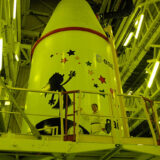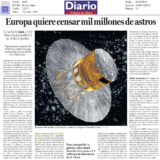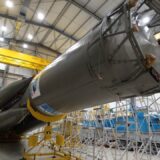Gaia ephemeris
The GBOT team has developed a web page with the Gaia ephemeris. The first days after the launch, Gaia should be visible with small/medium telescope. The web page is http://gaiainthesky.obspm.fr/
read moreSoyuz launcher and Gaia at the launch pad
Soyuz launcher and Gaia are already at the launch pad! The Soyuz launcher that will propel Gaia into space was moved to its launch pad at the spaceport in Kourou. The sixth Soyuz to be launched from this space center in South America was leaving the processing building (called MIK) on a special transport vehicle on rails for this trip to the launch pad in about 700 m distance. It passed through the mobile gantry before reaching its final destination (before being launched). At the launch pad the rocket was erected by a hydraulical system located on the mobile transporter. This is an...
read moreEuropa quiere censar mil millones de astros, Diario de Noticias, 3 Dec 2013
Newspaper: Diario de Noticias, Diario de Noticias álava Tittle: “Europa quiere censar mil millones de estrellas” Pdf file: http://www.noticiasdealava.com/2013/12/03/sociedad/europa-quiere-censar-mil-millones-de-astros http://www.noticiasdenavarra.com/2013/12/03/sociedad/estado/europa-quiere-censar-mil-millones-de-astros Publication date: 3 December 2013 La humanidad siempre ha trazado mapas. Mapas del mundo, de las ciudades, de las montañas, de los mares… y del cielo. Si, al caer la noche, alzamos la vista para contemplar el firmamento, es posible que atisbemos,...
read moreGaia launch date
Gaia the astrometry mission, sixth corner stone of the scientific programme of the European Space Agency including the missions Rosetta, Herschel, Planck, Lisa and BepiColombo, finally has a launch date: December 19. Gaia, which was first proposed in 1993, is expected to be launched on board a Soyuz rocket from the Centre Spatial Guyanais (CSG) in French Guiana in South America, to begin its mission to map more than one billion stars, creating an astronomical census and map to help scientists chart the evolution of the Milky Way galaxy. The Soyuz 2-1b rocket will...
read moreGaia sunshield deployment test successful
Gaia has passed its critical sunshield deployment test. During the test at Europe’s spaceport in Kourou the shield’s twelve carbon fibre folding frames were opened successfully in the cleanroom. As the Deployable Sunshield Assembly (DSA) was not designed to support its own weight in the one-g environment at Earth’s surface, support cables and counterweights attached to the shield provided a realistic test environment. In space the 10.5 metre diameter sunshield will shade the spacecraft’s telescope from the sun. It will also help to provide a stable and low temperature...
read more









